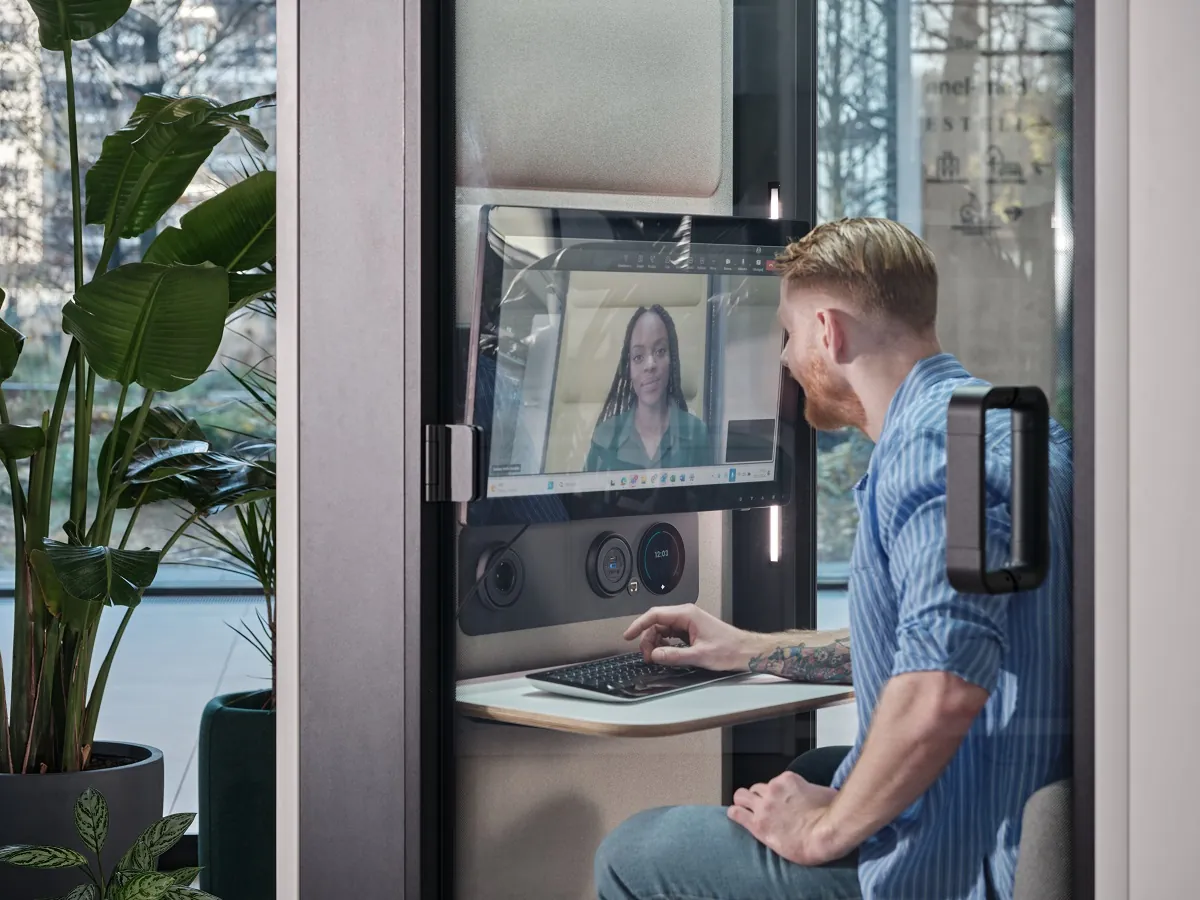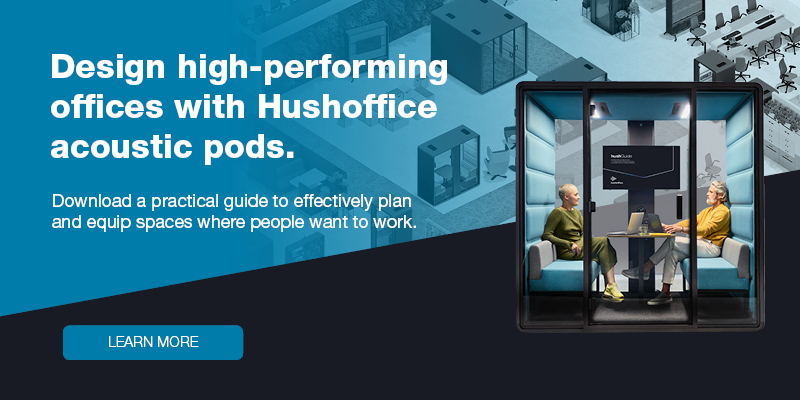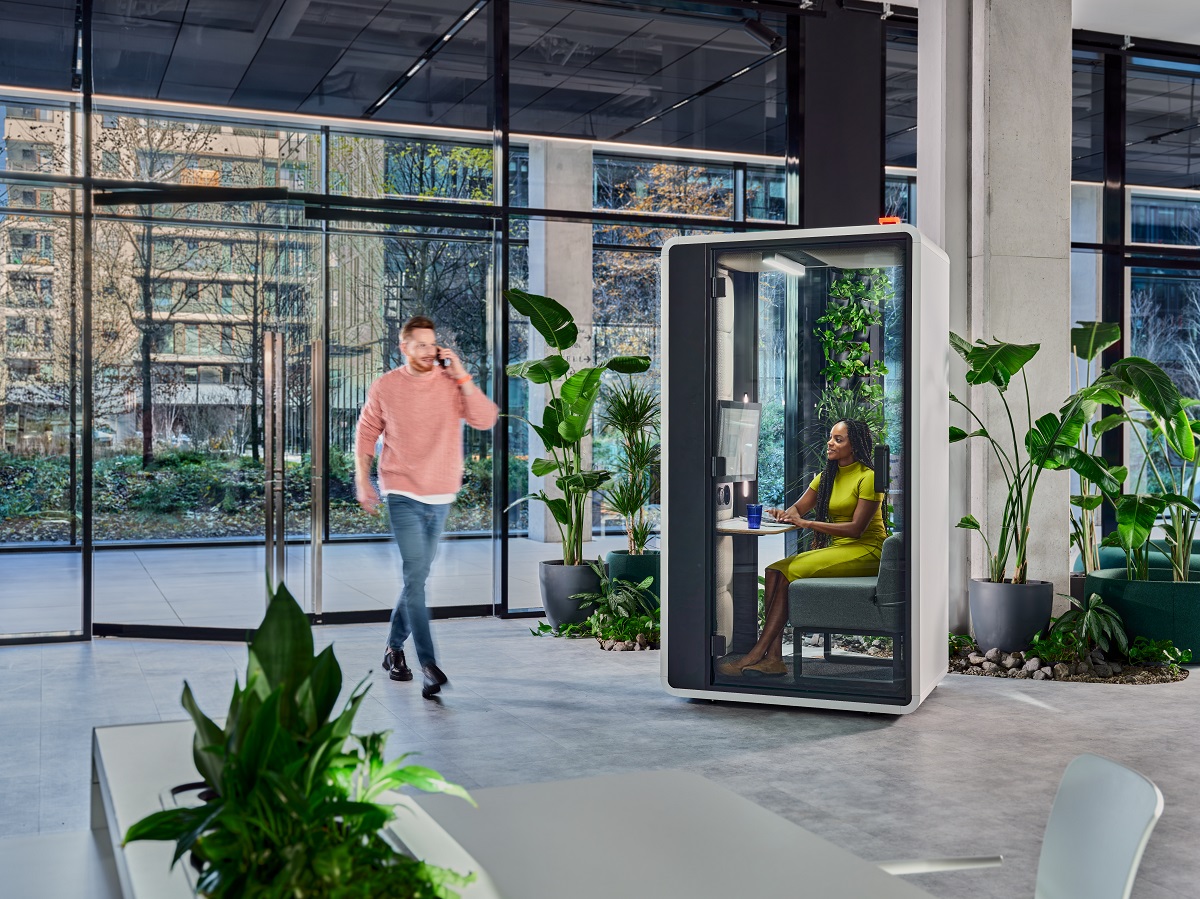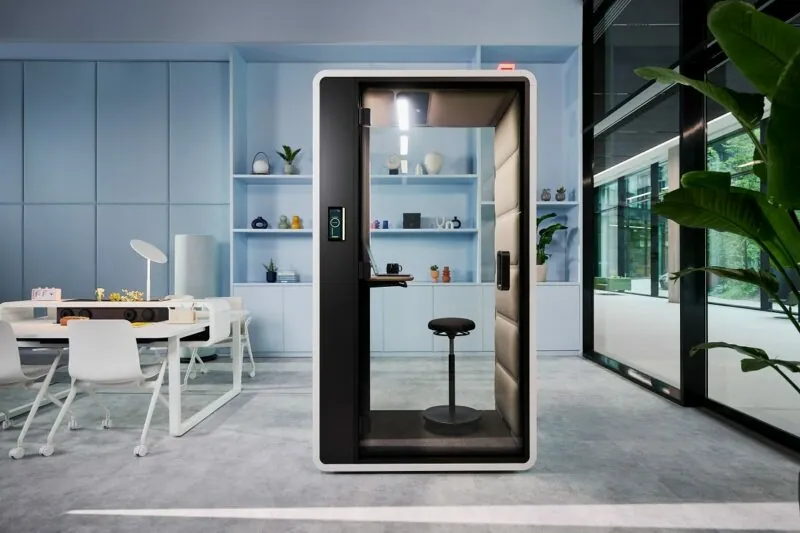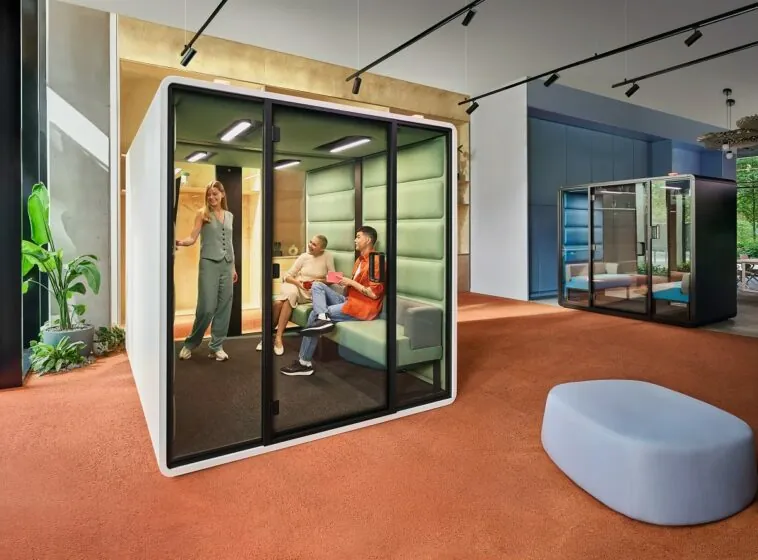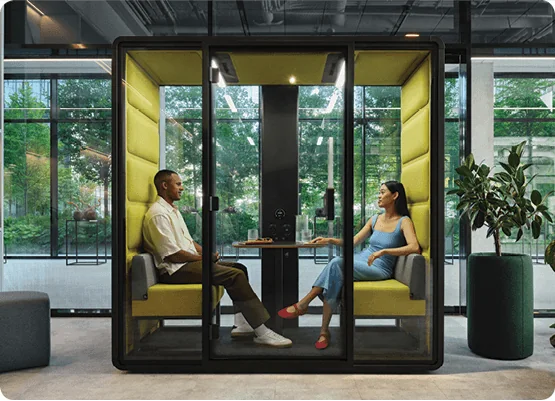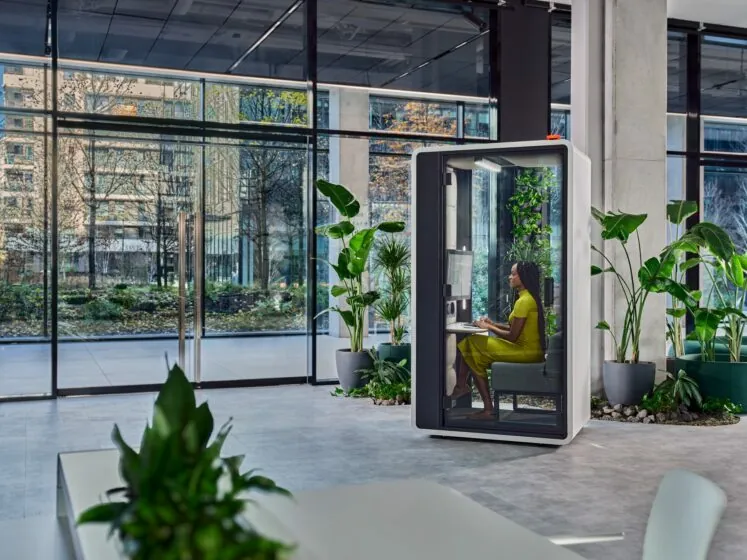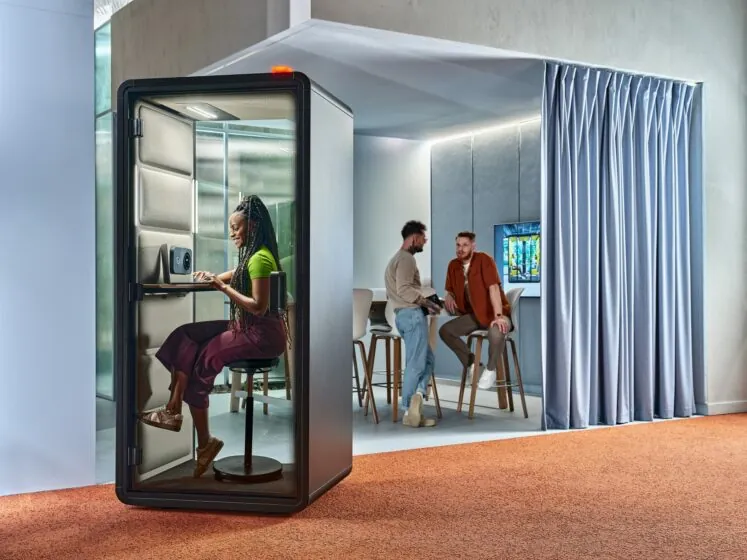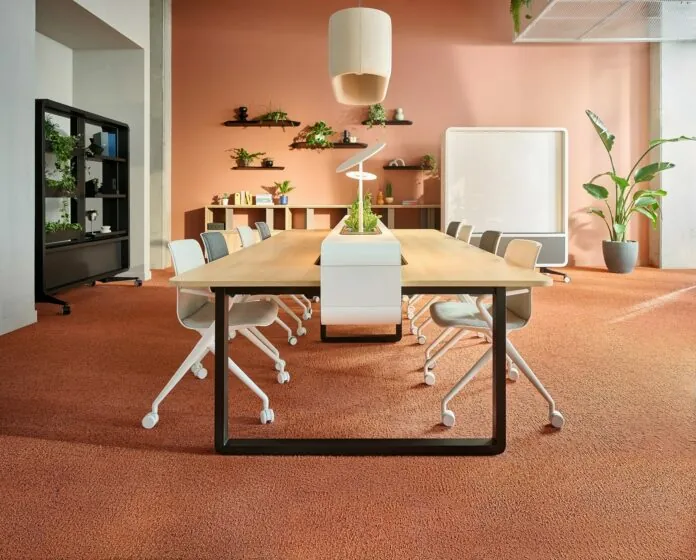Is it alright to spend the entire day in a work pod?
- Posted on: 27 May 2025
- By: Hushoffice Team
Acoustic booths such as hushFree are built for targeted use — not a full-time workstation, but tools. They serve as on-demand environments for deep concentration or discreet conversations. Used with thought and consideration, they add substantial value to a modern office.
Is it alright to spend the entire day in a work pod? Tl;dr
- Booths and pods aren’t intended for all-day use. They work best when used in short bursts — for meetings, tasks, calls, or a brief rest. Their true power lies in the sense of autonomy they provide, which contributes meaningfully to employee wellbeing.
- Acoustic pods and booths offer more than quiet — they support balance. While noise reduction is key, their deeper value is in enabling flow between collaborative and solo work.
- Unlike remote work or fully closed offices, pods provide structured privacy while not cutting people off. They allow individuals to adjust their environment and stay engaged with team culture at the same time.
- Booths such as hushFree boost office functionality without costly remodelling. Compared to fixed builds, they’re flexible, mobile, and designed to maximise space while meeting evolving needs.
Is quiet in the office a luxury or a necessity?
Silence is often seen as optional — a bonus. But in reality, it’s essential. Focused work needs silence. The fact is, noise pollution in the office not only overloads the mind but wears down productivity and increases stress.
More than silence — acoustic pods bring the office together.
The function of pods goes well beyond just quiet. In a well-designed workplace, they’re a core component. Inside, you get sharper thinking and smoother conversations. Better outcomes follow. Of course, they block noise and reduce distractions — but more importantly, they give people control over their environment. That sense of control is vital in high-activity offices. These booths don’t just help; they’re essential
– says Hushoffice Principal Brand Manager, Mateusz Barczyk.
A balance of seclusion and connection …
Pods let people step out of the noise — without stepping away from the office space entirely.
Designing for sensory needs and neurodiversity…
Everyone experiences sound differently. Some thrive in buzz; others need silence to think clearly. Hushed booths are a welcoming solution — they offer consistent, low-stimulus space without drawing attention to individual preferences.
Encouraging natural movement throughout the day…
By supporting task-specific work, pods help break up sedentary patterns. Employees move between open areas and enclosed pods as their workflow demands — increasing focus while reducing fatigue.
Optimising space without altering the floor plan…
Booths offer an easy way to carve out private areas — no walls, no rebuilds. They’re compact, efficient, and adaptable, making them a smart alternative to fixed layouts.
Supporting mental focus and wellbeing…
A world full of pings and interruptions means that access to a quiet space is more than helpful — it’s necessary. Pods act as spaces to focus, regroup, or mentally reset.
A calm booth offers real relief in a bustling office.
Busy offices are energising, but only to a point. Even real extroverts need time away from the buzz. That’s where sound-insulated booths come in — offering a place to refocus and recharge.
Stillness sparks better thinking.
Regular retreat makes creative thinking more integrated. After a focused session of ‘alonement’ in a pod — maybe to write an email or take a call in private — rejoining the buzz of the open floor feels more natural and energising.
Air and light matter just as much as silence.
Quiet doesn’t guarantee productivity. Airflow and lighting are just as crucial. That’s why hushFree booths feature top-tier ventilation to keep air circulating and prevent fatigue. We’ve also integrated lighting that supports focus and avoids the visual strain caused by poor illumination
– says Hushoffice Principal Brand Manager, Mateusz Barczyk.
Can pods replace a standard desk setup? Not quite.
Pods aren’t intended to stand in for desks — they enhance the workspace ecosystem. It isn’t a good idea to sit in one spot all day, whether it’s at a desk or inside a pod. The goal is variety. Pods create moments of retreat and focus, complementing — not replacing — traditional workstations.
A quiet space where mental clarity can be found.
The modern world is noisy. A pod offers “hush” where the brain can rest. The mind needs to move from stimulation to solitude and back, and the pod provides a space for this — a soft pause to reorganise thoughts and ideas take off.
Can excessive quiet feel oppressive? Yes.
Total silence can be unsettling — like the strange feeling inside an echo-free chamber where every sound, even your breath, feels loud. That’s why we tuned hushFree booths to create a gentle hush, not complete stillness. They filter out distractions but don’t make you feel cut off. It’s the balance that makes them effective. You enter when you need to concentrate — and step back out when you’re ready to rejoin the energy
– says Hushoffice Principal Brand Manager, Mateusz Barczyk.
What are the physical effects of work in a small, enclosed space?
Even with top-grade ventilation and light, staying inside a pod for too long can feel confining. The key is variety — a mix of settings throughout the day. Moving between pods, lounges, and open-plan areas helps maintain comfort and focus.
What happens psychologically with too much isolation?
We’re social creatures by nature. Excessive solitude at work can cause a feeling of disconnect from others and erode belonging. The healthiest rhythm usually blends heads-down work with regular social interaction.
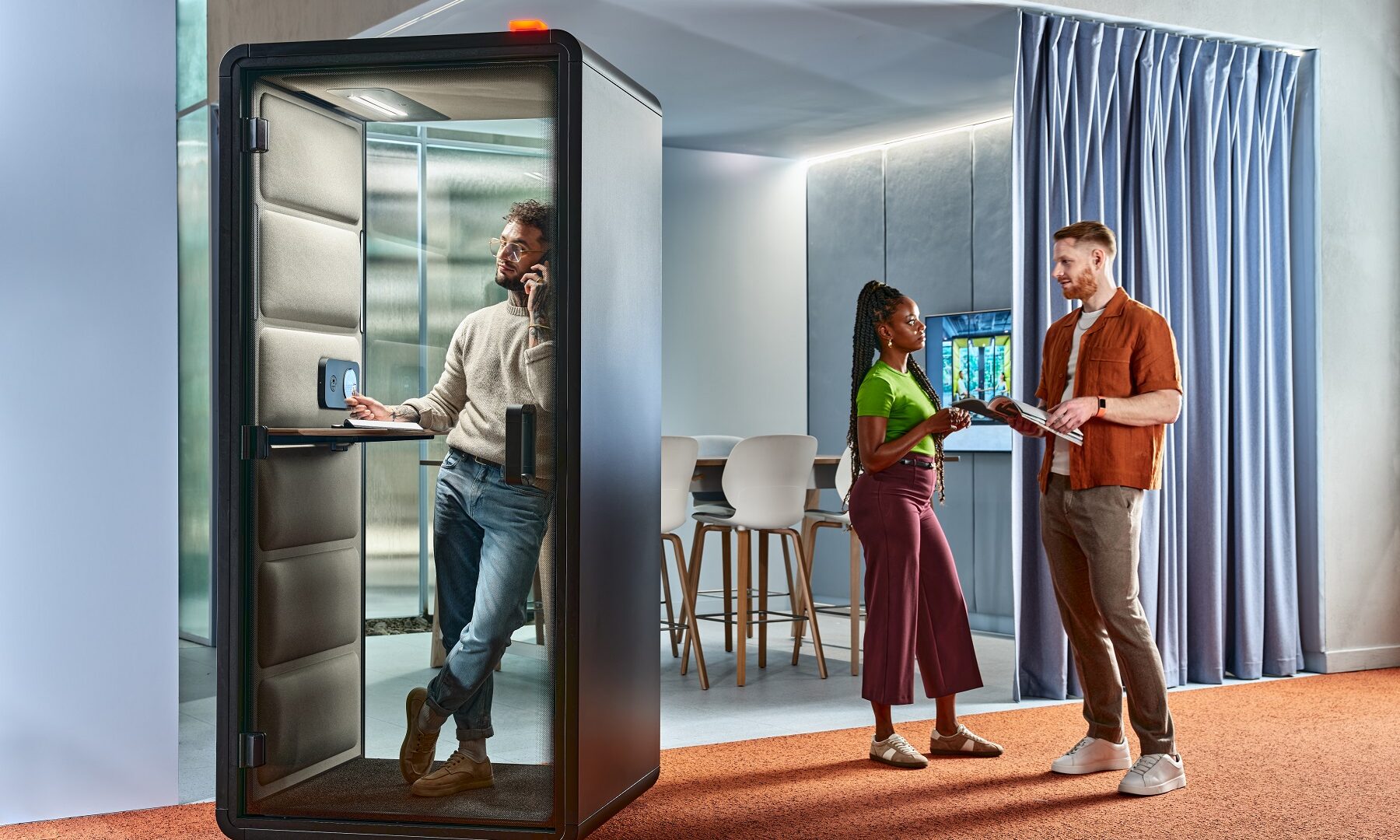
Are booths good for all-day working?
Short answer: not really. The strength of a pod lies in how accessible it is — not in staying in one from morning to night, but in being able to do so when needed. Productivity is about flexibility, not confinement.
How long is it healthy to work inside a pod?
It depends on what you’re doing, but generally, pods are best used in 30–60 minute sessions. With sit-stand models such as the hushFree.S, posture can be varied over longer periods. And hushAssistant makes it easy to set break reminders — helping encourage better habits.
Pods aren’t replacements for desks — they complement them.
An acoustic booth is like the study corner in a great library — ideal for deep work, but not where you’d spend every hour. The best office setups offer a range of furniture types and work zones. Pods are part of that wider design.
Getting the balance right: solitude and team connection.
Pods give structure to solo time, but make it easy to rejoin the group at will. The ability to shift between quiet and community is what makes pods so effective — they support both focus and collaboration, without forcing a choice between the two.
Why ‘opt-out’ spaces reduce stress.
Just knowing a quiet space is always available gives employees peace of mind. It means less frustration, especially in a noisy office, and helps staff feel more in control of their environment.
Quiet booths also ease mental overload from too many decisions.
Rather than scouting around for an unused meeting room or empty spot, pods offer a consistent go-to space. This reduces mental effort and keeps workflows smooth.
When is using a pod the smart choice for a task?
Some tasks just make more sense in a work booth.
For deep, demanding work …
If the task at hand needs full mental focus — such as reviewing detailed material or writing complex content — then a solo booth such as the hushFree.XS is ideal. It shields you from outside interruptions so you can truly engage.
For private conversations and online calls…
Open-plan offices are risky for confidential chats. For anything sensitive — whether video or phone — a hushFree.S.Hybrid pod gives the perfect professional setting. Sound stays private, and you don’t disrupt colleagues nearby.
For stepping away from sensory overload…
Sometimes it’s not about the task — it’s about the brain needing a pause. A comfortable pod like hushFree.M with sofa seating gives you that break. Like all hushFree models, lighting and airflow can be adjusted for comfort.
Is it alright to spend the entire day in a work pod – summarized
- Booths and pods aren’t intended for all-day use. They work best when used in short bursts — for meetings, tasks, calls, or a brief rest. Their true power lies in the sense of autonomy they provide, which contributes meaningfully to employee wellbeing.
- Acoustic pods and booths offer more than quiet — they support balance. While noise reduction is key, their deeper value is in enabling flow between collaborative and solo work.
- Unlike remote work or fully closed offices, pods provide structured privacy while not cutting people off. They allow individuals to adjust their environment and stay engaged with team culture at the same time.
- Booths such as hushFree boost office functionality without costly remodelling. Compared to fixed builds, they’re flexible, mobile, and designed to maximise space while meeting evolving needs.
Hushoffice FAQ
Can booths really reduce fatigue at work?
Yes! They give people a space to take a respite from the continuous buzz of the office. By allowing short retreats into a quieter setting, booths help avoid mental fatigue and restore energy. They support focus and reduce stress — all of which helps employees manage their energy over the whole day.
Do pods help improve work-life balance?
Definitely. When people can manage their work setting more directly, they feel less worn out. Being able to choose between social interaction and quiet space allows for better pacing of the workday. This balance keeps burnout at bay — especially for those sensitive to overstimulation or prolonged solitude.
How do pods support different ways of working?
Every team includes a range of preferences. Some people need high-energy environments to thrive. Others think best in peace and quiet. Pods make room for both. They provide introverts somewhere they can recharge and give extroverts the silence needed for deep focus. That’s how a truly inclusive space works — it adapts to people, not the other way around.
